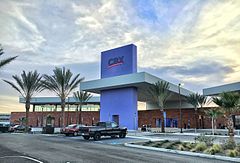Cross Border Xpress
| Cross Border Xpress (CBX) Tijuana Cross-border Terminal |
|
|---|---|

Exterior of CBX terminal on the U.S. side
|
|
|
(San Diego–Tijuana) |
|
| General information | |
| Type | Airport terminal |
| Location | U.S.–Mexico border |
| Address | 2745 Otay Pacific Drive, San Diego, CA 92173 |
| Coordinates | 32°32′54″N 116°58′28″W / 32.54833°N 116.97444°WCoordinates: 32°32′54″N 116°58′28″W / 32.54833°N 116.97444°W |
| Construction started | June 2014 |
| Completed | December 2015 |
| Inaugurated | December 9, 2015 |
| Cost | $120 million |
| Client | Bancomext and Invex |
| Owner | Otay Tijuana Venture, LLC |
| Technical details | |
| Floor area | 65,000 sq ft |
| Design and construction | |
| Architect | Stantec, Ricardo Legorreta |
| Architecture firm | Stantec, Legoretta + Legoretta |
| Other designers | Ralph Nieders |
| Main contractor | Turner Construction, Hazard Construction (San Diego), Grumesa S.A. de C. V. (Mexico) |
| Website | |
| Cross Border Xpress | |
| References | |
| Otay Tijuana Venture | |
Cross Border Xpress (CBX), also referred to as the Tijuana Cross-border Terminal and the Puerta de las Californias, is an airport terminal located in San Diego, California, United States, with an access bridge connecting it to the Tijuana International Airport in Tijuana, Baja California, Mexico. It opened on December 9, 2015. It is the world's first true binational airport passenger terminal. Unlike the EuroAirport Basel–Mulhouse–Freiburg – which is entirely in France, despite being jointly administered with Switzerland – the CBX terminal is physically located in the United States but serves the Tijuana airport. A pedestrian bridge spans the United States–Mexico border, connecting passenger terminals between the two countries. It was the creation of Ralph Nieders, who introduced the concept and infrastructure design in Mexico City in 1989 and San Diego in 1990.
The terminal, in the Otay Mesa neighborhood of San Diego, allows passengers to check in on the U.S. side of the U.S.–Mexico border, cross a 390-foot (120 m) pedestrian/passenger bridge across the border, clear Mexican immigration and customs, and catch their flights at the Tijuana International Airport. Passengers arriving in Tijuana are equally able to cross the pedestrian/passenger bridge into the Otay Mesa passenger terminal, clear U.S. passport controls and U.S. Customs, and exit on the U.S. side. The terminal building in Otay Mesa serves only as a check-in and processing facility for departing and arriving passengers. It has its own parking, check-in stations, and customs offices, but no gates or arrival facilities (thus functionally resembling Hong Kong International Airport's Terminal 2). The structural scheme is intended to allow greater access to flights out of Tijuana Airport for both domestic and international air carriers.
...
Wikipedia

